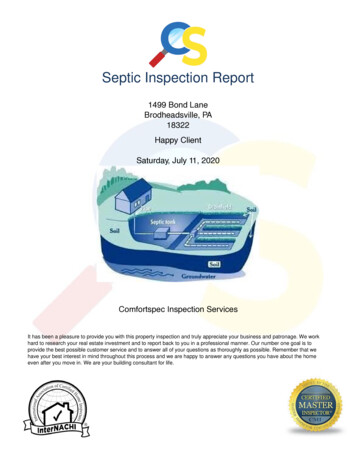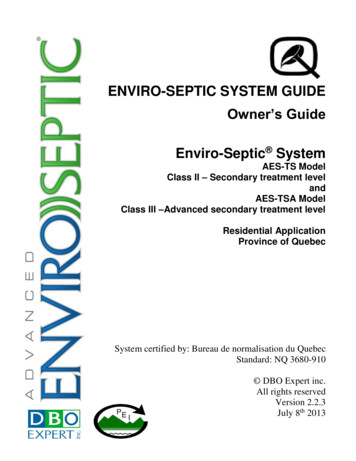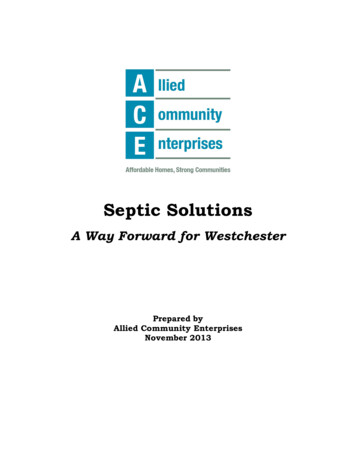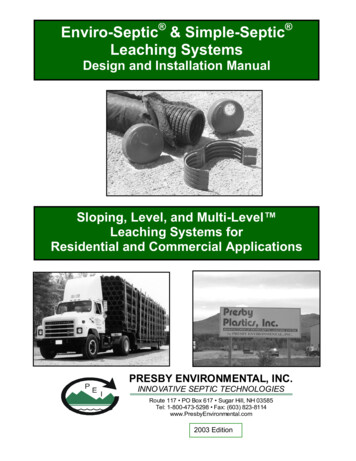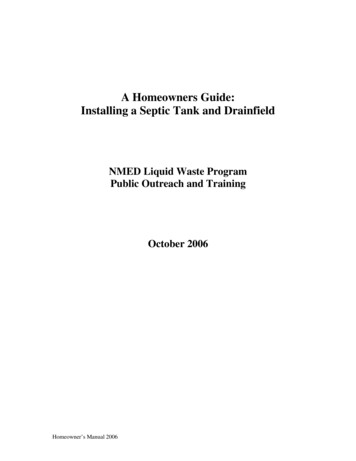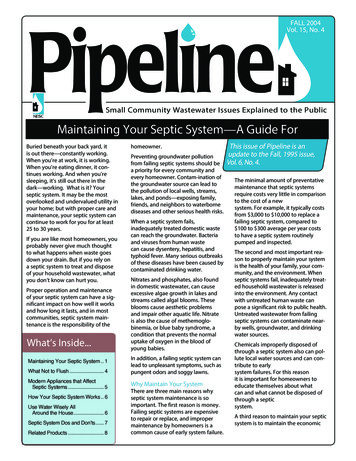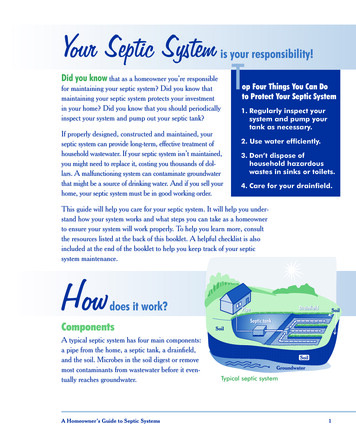
Transcription
Your Septic Systemis your responsibility!TDid you know that as a homeowner you’re responsibleop Four Things You Can Doto Protect Your Septic Systemfor maintaining your septic system? Did you know thatmaintaining your septic system protects your investmentin your home? Did you know that you should periodicallyinspect your system and pump out your septic tank?If properly designed, constructed and maintained, yourseptic system can provide long-term, effective treatment ofhousehold wastewater. If your septic system isn’t maintained,you might need to replace it, costing you thousands of dollars. A malfunctioning system can contaminate groundwaterthat might be a source of drinking water. And if you sell yourhome, your septic system must be in good working order.1. Regularly inspect yoursystem and pump yourtank as necessary.2. Use water efficiently.3. Don’t dispose ofhousehold hazardouswastes in sinks or toilets.4. Care for your drainfield.This guide will help you care for your septic system. It will help you understand how your system works and what steps you can take as a homeownerto ensure your system will work properly. To help you learn more, consultthe resources listed at the back of this booklet. A helpful checklist is alsoincluded at the end of the booklet to help you keep track of your septicsystem maintenance.Howdoes it work?ComponentsA typical septic system has four main components:a pipe from the home, a septic tank, a drainfield,and the soil. Microbes in the soil digest or removemost contaminants from wastewater before it eventually reaches groundwater.A Homeowner’s Guide to Septic SystemsTypical septic system1
Septic system aliases: On-lot systemPipe from the home Onsite systemAll of your household wastewater exits your homethrough a pipe to the septic tank. Individual sewagedisposal systemSeptic tankThe septic tank is a buried, watertight container typicallymade of concrete, fiberglass, or polyethylene. It holds thewastewater long enough to allow solids to settle out (form Onsite wastewatering sludge) and oil and grease to float to the surface (astreatment systemscum). It also allows partial decomposition of the solidmaterials. Compartments and a T-shaped outlet in theseptic tank prevent the sludge and scum from leaving the tank and travelinginto the drainfield area. Screens are also recommended to keep solids fromentering the drainfield. Onsite sewagedisposal systemNewer tanks generally have risers with lids at the ground surface to alloweasy location, inspection, and pumping of the tank.Typical single-compartment septic tank with ground-level inspectionrisers and screenTip To prevent buildup, sludge and floating scum need to be removed2through periodic pumping of the septic tank. Regular inspectionsand pumping are the best and cheapest way to keep your septicsystem in good working order.A Homeowner’s Guide to Septic Systems
Finding Your SystemYour septic tank, drainfield, and reserve drainfieldshould be clearly designated on the“as-built” drawing for your home. (An“as-built” drawing is a line drawing thataccurately portrays the buildings on yourproperty and is usually filed in your localland records.) You might also see lids ormanhole covers for your septic tank. Oldertanks are often hard to find because thereare no visible parts. An inspector/pumpercan help you locate your septic system ifyour septic tank has no risers.DrainfieldThe wastewater exits the septic tank and is discharged into the drainfieldfor further treatment by the soil. The partially treated wastewater is pushedalong into the drainfield for further treatment every time new wastewaterenters the tank.If the drainfield is overloaded with too much liquid, it will flood, causingsewage to flow to the ground surface or create backups in plumbing fixturesand prevent treatment of all wastewater.A reserve drainfield, required by many states, is an area on your propertysuitable for a new drainfield system if your current drainfield fails. Treatthis area with the same care as your septic system.SoilSeptic tank wastewater flows to the drainfield, where it percolates into thesoil, which provides final treatment by removing harmful bacteria, viruses,and nutrients. Suitable soil is necessary for successful wastewater treatment.Alternative systemsBecause many areas don’t have soils suitable for typical septic systems, youmight have or need an alternative system. You might also have or need analternative system if there are too many typical septic systems in one area orthe systems are too close to groundwater or surface waters. Alternative septicA Homeowner’s Guide to Septic Systems3
systems use new technology to improve treatment processes and might needspecial care and maintenance. Some alternative systems use sand, peat,or plastic media instead of soil to promote wastewater treatment. Othersystems might use wetlands, lagoons, aerators, or disinfection devices.Float switches, pumps, and other electrical or mechanical components areoften used in alternative systems. Alternative systems should be inspectedannually. Check with your local health department or installer for moreinformation on operation and maintenance needs if you have or need analternative system.Whyshould I maintain my septic system?When septic systems are properly designed, constructed, and maintained,they effectively reduce or eliminate most human health or environmentalthreats posed by pollutants in household wastewater. However, they requireregular maintenance or they can fail. Septic systems need to be monitored toensure that they work properly throughout their service lives.Saving moneyA key reason to maintain your septic system is to save money! Failing septicsystems are expensive to repair or replace, and poor maintenance is oftenthe culprit. Having your septic system inspected regularly is a bargain whenyou consider the cost of replacing the entire system. Your system will needpumping depending on how many people live in the house and the size ofthe system. An unusable septic system or one in disrepair will lower yourproperty value and could pose a legal liability.Protecting health and the environmentOther good reasons for safe treatment of sewage include preventing thespread of infection and disease and protecting water resources. Typicalpollutants in household wastewater are nitrogen, phosphorus, and disease-4A Homeowner’s Guide to Septic Systems
causing bacteria and viruses. If a septic system is working properly, it willeffectively remove most of these pollutants.With one-fourth of U.S. homes using septic systems, more than 4 billiongallons of wastewater per day is dispersed below the ground’s surface.Inadequately treated sewage from septic systems can be a cause of groundwater contamination. It poses a significant threat to drinking water andhuman health because it can contaminate drinking water wells and causediseases and infections in people and animals. Improperly treated sewagethat contaminates nearby surface waters also increases the chance ofswimmers contracting a variety of infectious diseases. These range from eyeand ear infections to acute gastrointestinal illness and diseases like hepatitis.Howdo I maintain my septic system?Inspect and pump frequentlyYou should have a typical septic system inspected at leastevery 3 years by a professional and your tank pumpedas recommended by the inspector (generally every 3 to 5years). Alternative systems with electrical float switches,pumps, or mechanical components need to be inspectedmore often, generally once a year. Your service providershould inspect for leaks and look at the scum and sludgelayers in your septic tank. If the bottom of the scum layer iswithin 6 inches of the bottom of the outlet tee or the top ofthe sludge layer is within 12 inches of the outlet tee, yourtank needs to be pumped. Remember to note the sludgeand scum levels determined by your service provider inyour operation and maintenance records. This informationwill help you decide how often pumping is necessary. (Seethe checklist included at the end of the booklet.)A Homeowner’s Guide to Septic SystemsWhat Does anInspection Include? Locating the system. Uncovering access holes. Flushing the toilets. Checking for signs ofback up. Measuring scum andsludge layers. Identifying any leaks. Inspecting mechanicalcomponents. Pumping the tank ifnecessary.5
Four major factors influence the frequency of pumping: the number ofpeople in your household, the amount of wastewater generated (based onthe number of people in the household and the amount of water used), thevolume of solids in the wastewater (for example, using a garbage disposalincreases the amount of solids), and septic tank size.Some makers of septic tank additives claim that their products break downthe sludge in septic tanks so the tanks never need to be pumped. Noteveryone agrees on the effectiveness of additives. In fact, septic tanksalready contain the microbes they need for effective treatment. Periodicpumping is a much better way to ensure that septic systems work properlyand provide many years of service. Regardless, every septic tank requiresperiodic pumping.In the service report, the pumper should note any repairs completed andwhether the tank is in good condition. If the pumper recommends additional repairs he or she can’t perform, hire someone to make the repairs assoon as possible.Use water efficientlyAverage indoor water use in the typical single-family home is almost70 gallons per person per day. Leaky toilets can waste as much as 200gallons each day. The more water a household conserves, the less waterenters the septic system. Efficient water use can improve the operation ofthe septic system and reduce the risk of failure.High-efficiency toiletsToilet use accounts for 25 to 30 percent of household water use. Do youknow how many gallons of water your toilet uses to empty the bowl? Mostolder homes have toilets with 3.5- to 5-gallon reservoirs, while newerhigh-efficiency toilets use 1.6 gallons of water or less per flush. If you haveproblems with your septic system being flooded with household water,consider reducing the volume of water in the toilet tank if you don’t have ahigh-efficiency model or replacing your existing toilets with high-efficiencymodels.6A Homeowner’s Guide to Septic Systems
Faucet aerators and highefficiency showerheadsFaucet aerators help reduce water useand the volume of water entering yourseptic system. High-efficiency showerheads or shower flow restrictors alsoreduce water use.Water fixturesCheck to make sure your toilet’sreservoir isn’t leaking into the bowl.Add five drops of liquid food coloringto the reservoir before bed. If the dyeis in the bowl the next morning, thereservoir is leaking and repairs areneeded.A small drip from a faucet adds manygallons of unnecessary water to yoursystem every day. To see how much aleak adds to your water usage, placea cup under the drip for 10 minutes.Multiply the amount of water in thecup by 144 (the number of minutes in24 hours, divided by 10). This is thetotal amount of clean water traveling toyour septic system each day from thatlittle leak.A Homeowner’s Guide to Septic SystemsUse Water Efficiently! Install high-efficiency showerheads Fill the bathtub with only as muchwater as you need Turn off faucets while shaving orbrushing your teeth Run the dishwasher and clotheswasher only when they’re full Use toilets to flush sanitary wasteonly (not kitty litter, diapers, orother trash) Make sure all faucets arecompletely turned off when not inuse Maintain your plumbing toeliminate leaks Install aerators in the faucets inyour kitchen and bathroom Replace old dishwashers, toilets,and clothes washers with new, highefficiency models.For more information on waterconservation, please visitwww.epa.gov/owm/water-efficiency/index.htm7
Watch your drainsWhat goes down the drain can have a major impact on how well yourseptic system works.Waste disposalWhat shouldn’t you flush down your toilet? Dental floss, feminine hygieneproducts, condoms, diapers, cotton swabs, cigarette butts, coffee grounds,cat litter, paper towels, and other kitchen and bathroom items that can clogand potentially damage septic system components if they become trapped.Flushing household chemicals, gasoline, oil, pesticides, antifreeze, and paintcan stress or destroy the biological treatment taking place in the systemor might contaminate surface waters and groundwater. If your septic tankpumper is concerned about quickly accumulating scum layers, reduce theflow of floatable materials like fats, oils, and grease into your tank or beprepared to pay for more frequent inspections and pumping.Washing machinesBy selecting the proper load size, you’llreduce water waste. Washing small loadsof laundry on the large-load cycle wastesprecious water and energy. If you can’tselect load size, run only full loads oflaundry.Doing all the household laundry in one daymight seem like a time-saver, but it could be harmfulto your septic system. Doing load after load does not allow yourseptic tank time to adequately treat wastes. You could be flooding yourdrainfield without allowing sufficient recovery time. Try to spread waterusage throughout the week. A new Energy Star clothes washer uses35 percent less energy and 50 percent less water than a standard model.8A Homeowner’s Guide to Septic Systems
Care for your drainfieldYour drainfield is an important part of your septic system. Here are a fewthings you should do to maintain it: Plant only grass over and near your septic system. Roots from nearbytrees or shrubs might clog and damage the drainfield. Don’t drive or park vehicles on any part of your septic system. Doingso can compact the soil in your drainfield or damage the pipes, tank, orother septic system components. Keep roof drains, basement sump pump drains, and other rainwater orsurface water drainage systems away from the drainfield. Flooding thedrainfield with excessive water slows down or stops treatment processesand can cause plumbing fixtures to back up.Whatcan make my system fail?If the amount of wastewater entering the system is more than the system canhandle, the wastewater backs up into the house or yard and creates a healthhazard.You can suspect a system failure not only when a foul odor is emitted butalso when partially treated wastewater flows up to the ground surface. Bythe time you can smell or see a problem, however, the damage mightalready be done.By limiting your water use, you can reduce the amount of wastewater yoursystem must treat. When you have your system inspected and pumped asneeded, you reduce the chance of system failure.A system installed in unsuitable soils can also fail. Other failure risksinclude tanks that are inaccessible for maintenance, drainfields that arepaved or parked on, and tree roots or defective components that interferewith the treatment process.A Homeowner’s Guide to Septic Systems9
Failure symptomsThe most obvious septic system failures are easy to spot. Check for poolingwater or muddy soil around your septic system or in your basement. Noticewhether your toilet or sink backs up when you flush or do laundry. Youmight also notice strips of bright green grass over the drainfield. Septicsystems also fail when partially treated wastewater comes into contact withgroundwater. This type of failure is noteasy to detect, but it can result in the pollution of wells, nearby streams, or otherbodies of water. Check with a septicsystem professional and the local healthdepartment if you suspect such a failure.Stop, look, and smell!Failure causesHousehold toxicsDoes someone in your house use the utility sink to clean out paint rollersor flush toxic cleaners? Oil-based paints, solvents, and large volumes oftoxic cleaners should not enter your septic system. Even latex paint cleanupwaste should be minimized. Squeeze all excess paint and stain frombrushes and rollers on several layers of newspaper before rinsing. Leftoverpaints and wood stains should be taken to your local household hazardouswaste collection center. Remember that your septic system contains a livingcollection of organisms that digest and treat waste.Household cleanersFor the most part, your septic system’s bacteria should recover quicklyafter small amounts of household cleaning products have enteredthe system. Of course, some cleaning products are less toxic toyour system than others. Labels can help key you into the potentialtoxicity of various products. The word “Danger” or “Poison” on alabel indicates that the product is highly hazardous. “Warning” tellsyou the product is moderately hazardous. “Caution” means theproduct is slightly hazardous. (“Nontoxic” and “Septic Safe”10A Homeowner’s Guide to Septic Systems
are terms created by advertisers to sell products.) Regardless of the typeof product, use it only in the amounts shown on the label instructions andminimize the amount discharged into your septic system.Hot tubsHot tubs are a great way to relax.Unfortunately, your septic system wasnot designed to handle large quantitiesof water from your hot tub. Emptyinghot tub water into your septic system stirsthe solids in the tank and pushes them out into thedrainfield, causing it to clog and fail. Draining your hot tubinto a septic system or over the drainfield can overload the system. Instead,drain cooled hot tub water onto turf or landscaped areas well away fromthe septic tank and drainfield, and in accordance with local regulations.Use the same caution when draining your swimming pool.Water Purification SystemsSome freshwater purification systems, including water softeners, unnecessarily pump water into the septic system. This can contribute hundreds ofgallons of water to the septic tank, causing agitation of solids and excessflow to the drainfield. Check with your licensed plumbing professionalabout alternative routing for such freshwater treatment systems.Garbage disposalsEliminating the use of a garbage disposal can reduce the amount ofgrease and solids entering the septic tank and possibly clogging thedrainfield. A garbage disposal grinds up kitchen scraps, suspendsthem in water, and sends the mixture to the septic tank. Once inthe septic tank, some of the materials are broken down by bacterial action, but most of the grindings have to be pumped out ofthe tank. Using a garbage disposal frequently can significantlyincrease the accumulation of sludge and scum in your septic tank,resulting in the need for more frequent pumping.A Homeowner’s Guide to Septic Systems11
Improper design or installationSome soils provide excellent wastewater treatment; others don’t. For thisreason, the design of the drainfield of a septic system is based on the resultsof soil analysis. Homeowners and system designers sometimes underestimate the significance of good soils or believe soils can handle any volumeof wastewater applied to them. Many failures can be attributed to havingan undersized drainfield or high seasonal groundwater table. Undersizedseptic tanks—another design failure—allow solids to clog the drainfieldand result in system failure.If a septic tank isn’t watertight, water can leak into and out of the system.Usually, water from the environment leaking into the system causes hydraulicoverloading, taxing the system beyond its capabilities and causing inadequatetreatment and sometimes sewage to flow up to the ground surface. Waterleaking out of the septic tank is a significant health hazard because the leaking wastewater has not yet been treated.Even when systems are properly designed, failures due to poor installationpractices can occur. If the drainfield is not properly leveled, wastewater canoverload the system. Heavy equipment can damage the drainfield duringinstallation which can lead to soil compaction and reduce the wastewaterinfiltration rate. And if surface drainage isn’t diverted away from the field,it can flow into and saturate the drainfield.12A Homeowner’s Guide to Septic Systems
Formore informationLocal Health DepartmentEPA Onsite/Decentralized Management Homepagewww.epa.gov/owm/septicEPA developed this Web site to provide tools for communities investigatingand implementing onsite/decentralized management programs. The Website contains fact sheets, program summaries, case studies, links to designand other manuals, and a list of state health department contacts that canput you in touch with your local health department.National Small Flows Clearinghousewww.nesc.wvu.eduFunded by grants from EPA, the NSFC helps America’s small communities and individuals solve their wastewater problems. Its activities includea Web site, online discussion groups, a toll-free assistance line (800624-8301), informative publications, and a free quarterly newsletter andmagazine.Rural Community Assistance Programwww.rcap.orgRCAP is a resource for community leaders and others looking for technicalassistance services and training related to rural drinking water supply andwastewater treatment needs, rural solid waste programs, housing, economicdevelopment, comprehensive community assessment and planning, andenvironmental regulations.National Onsite Wastewater Recycling Association, Inc.www.nowra.orgNOWRA is a national professional organization to advance and promotethe onsite wastewater industry. The association promotes the need forregular service and educates the public on the need for properly designedand maintained septic systems.A Homeowner’s Guide to Septic Systems13
Septic Yellow Pageswww.septicyellowpages.comThe Septic Yellow Pages provides listings by state for professional septicpumpers, installers, inspectors, and tank manufacturers throughoutthe United States. This Web site is designed to answer simple septicsystem questions and put homeowners in contact with local septic systemprofessionals.National Association of Wastewater Transporterswww.nawt.orgNAWT offers a forum for the wastewater industry to exchange ideas andconcerns. The NAWT Web site lists state associations and local inspectorsand pumpers.EPA-832-B-02-005December 2002Revised March 2005Additional copies can be obtained from:U.S. EPA Publications ClearinghouseP.O. Box 42419Cincinnati, OH 45241Telephone: 800-490-9198Fax: 513-489-8695Office of WaterU.S. Environmental Protection AgencyNoticeThis document has been reviewed in accordance with U.S. Environmental ProtectionAgency policy and approved for publication. Mention of profit-making organizations, tradenames, or commercial products does not constitute endorsement or recommendation for use.Recycled/RecyclablePrinted with vegetable-based ink on paper that contains a minimum of 50% post-consumerfiber content processed chlorine-free.14A Homeowner’s Guide to Septic Systems
Septic System Dos and Don’ts(adapted from National Small Flows Clearinghouse)Dos Check with the local regulatory agency or inspector/pumper if you have a garbage disposal unitto make sure that your septic system can handle this additional waste. Check with your local health department before using additives. Commercial septic tankadditives do not eliminate the need for periodic pumping and can be harmful to the system. Use water efficiently to avoid overloading the septic system. Be sure to repair leaky faucets ortoilets. Use high-efficiency fixtures. Use commercial bathroom cleaners and laundry detergents in moderation. Many people preferto clean their toilets, sinks, showers, and tubs with a mild detergent or baking soda. Check with your local regulatory agency or inspector/pumper before allowing water softenerbackwash to enter your septic tank. Keep records of repairs, pumpings, inspections, permits issued, and other system maintenanceactivities. Learn the location of your septic system. Keep a sketch of it with your maintenance record forservice visits. Have your septic system inspected and pumped as necessary by a licensed inspector/contractor. Plant only grass over and near your septic system. Roots from nearby trees or shrubs mightclog and damage the drainfield.Don’ts Your septic system is not a trash can. Don’t put dental floss, feminine hygiene products,condoms, diapers, cotton swabs, cigarette butts, coffee grounds, cat litter, paper towels, latexpaint, pesticides, or other hazardous chemicals into your system. Don’t use caustic drain openers for a clogged drain. Instead, use boiling water or a drain snaketo open clogs. Don’t drive or park vehicles on any part of your septic system. Doing so can compact the soilin your drainfield or damage the pipes, tank, or other septic system components.A Homeowner’s Guide to Septic Systems15
4 A Homeowner's Guide to Septic Systems A Homeowner's Guide to Septic Systems 5 causing bacteria and viruses. If a septic system is working properly, it will effectively remove most of these pollutants. With one-fourth of U.S. homes using septic systems, more than 4 billion gallons of wastewater per day is dispersed below the ground's .


